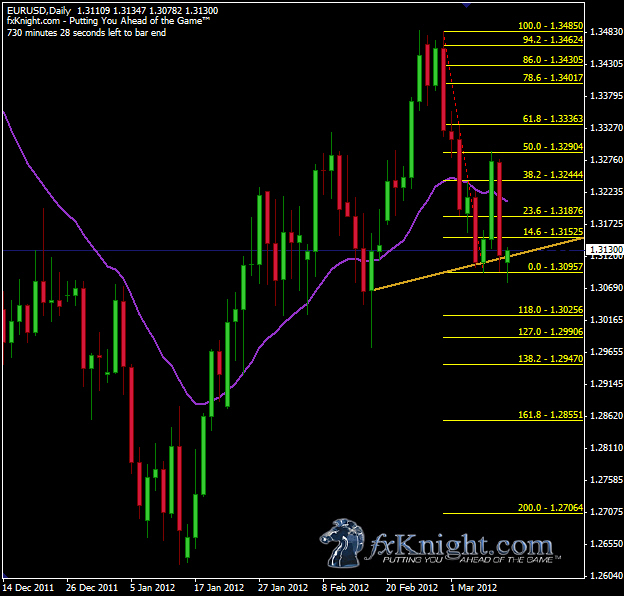There’s talk this morning of a Greek “credit event”, according to the ISDA. So what does that mean?
Well, first the good news – most likely Greece will get the 130 Billion Euros it needs. The IMF board is also voting on March 15th regarding a 4-year loan program for Greece for an additional 28 Billion Euros.
The problem is that by invoking a CAC (collective action clause), Greece is essentially forcing creditors to take a cut on the amount owed to them, in some instances by as much as 70%. This causes the triggering of credit default swaps, and the ISDA has scheduled an auction for March 19th to cover the nearly 3.2 Billion Euros in payouts outstanding so far.
Essentially, by declaring a “credit event” (the market and media friendly way of saying “default”), the ISDA is protecting the CDS market from further claims from creditors effected by the CAC.
What does all this mean for the Euro?
It depends on whether the markets put more emphasis on Greece receiving the bailout it needs, or on the fact that it had to default on the majority of its obligations in order to qualify for it.
As of now, we’re watching a key price level at 1.3117 on the EUR/USD – this is the critical “neck” line of a Head and Shoulders pattern on the Daily chart. If we close below this level today, very likely a prolonged down move will follow, taking us to 1.2855; if, on the other hand, 1.3117 can hold as support, we can expect this pair to continue chopping in the 1.3095 – 1.3290 range in the days ahead.
Across the Atlantic, the Fed will be releasing the latest Budget Balance figures for the US at 18:00 GMT, widely expected to widen from -27.4 Billion Dollars to -229.2 Billion. Here again, much will depend upon the market’s perception – a widening deficit can potentially be viewed as negative for the long-term economic outlook, but at the same time as creating greater demand for the currency. Once again, whether we close above or below 1.3117 when all the dust settles will be key.
- English (UK)
- English (India)
- English (Canada)
- English (Australia)
- English (South Africa)
- English (Philippines)
- English (Nigeria)
- Deutsch
- Español (España)
- Español (México)
- Français
- Italiano
- Nederlands
- Português (Portugal)
- Polski
- Português (Brasil)
- Русский
- Türkçe
- العربية
- Ελληνικά
- Svenska
- Suomi
- עברית
- 日本語
- 한국어
- 简体中文
- 繁體中文
- Bahasa Indonesia
- Bahasa Melayu
- ไทย
- Tiếng Việt
- हिंदी
The Greek "Credit Event" and What it Means for the Euro
Published 03/13/2012, 01:13 AM
Updated 05/14/2017, 06:45 AM
The Greek "Credit Event" and What it Means for the Euro
Latest comments
Loading next article…
Install Our App
Risk Disclosure: Trading in financial instruments and/or cryptocurrencies involves high risks including the risk of losing some, or all, of your investment amount, and may not be suitable for all investors. Prices of cryptocurrencies are extremely volatile and may be affected by external factors such as financial, regulatory or political events. Trading on margin increases the financial risks.
Before deciding to trade in financial instrument or cryptocurrencies you should be fully informed of the risks and costs associated with trading the financial markets, carefully consider your investment objectives, level of experience, and risk appetite, and seek professional advice where needed.
Fusion Media would like to remind you that the data contained in this website is not necessarily real-time nor accurate. The data and prices on the website are not necessarily provided by any market or exchange, but may be provided by market makers, and so prices may not be accurate and may differ from the actual price at any given market, meaning prices are indicative and not appropriate for trading purposes. Fusion Media and any provider of the data contained in this website will not accept liability for any loss or damage as a result of your trading, or your reliance on the information contained within this website.
It is prohibited to use, store, reproduce, display, modify, transmit or distribute the data contained in this website without the explicit prior written permission of Fusion Media and/or the data provider. All intellectual property rights are reserved by the providers and/or the exchange providing the data contained in this website.
Fusion Media may be compensated by the advertisers that appear on the website, based on your interaction with the advertisements or advertisers.
Before deciding to trade in financial instrument or cryptocurrencies you should be fully informed of the risks and costs associated with trading the financial markets, carefully consider your investment objectives, level of experience, and risk appetite, and seek professional advice where needed.
Fusion Media would like to remind you that the data contained in this website is not necessarily real-time nor accurate. The data and prices on the website are not necessarily provided by any market or exchange, but may be provided by market makers, and so prices may not be accurate and may differ from the actual price at any given market, meaning prices are indicative and not appropriate for trading purposes. Fusion Media and any provider of the data contained in this website will not accept liability for any loss or damage as a result of your trading, or your reliance on the information contained within this website.
It is prohibited to use, store, reproduce, display, modify, transmit or distribute the data contained in this website without the explicit prior written permission of Fusion Media and/or the data provider. All intellectual property rights are reserved by the providers and/or the exchange providing the data contained in this website.
Fusion Media may be compensated by the advertisers that appear on the website, based on your interaction with the advertisements or advertisers.
© 2007-2025 - Fusion Media Limited. All Rights Reserved.
